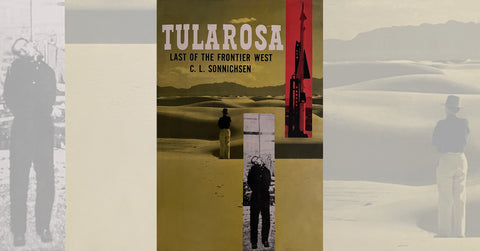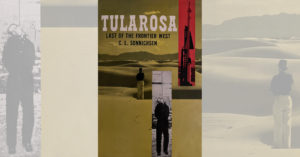
The 6 Best Western Histories, According to Wild West

Tularosa: Last of the Frontier West (1960, C.L. Sonnichsen): Here’s the powerful opening sentence that promises gritty frontier tales: “The Tularosa country is a parched desert where everything, from cactus to cowman, carries a weapon of some sort, and the only creatures who sleep with both eyes closed are dead.” Charles Leland Sonnichsen (1901–91) delivers an easy-to-read, ripsnorting history of New Mexico’s Tularosa Valley. Among the memorable characters who show up on these pages are Pat Garrett, Albert Jennings Fountain, Albert Fall, Oliver Lee and Bill McNew. The real story of Tularosa, Sonnichsen notes, is the story of Texas cattlemen, “proud riders who kept the Old West alive in that lonely land until yesterday.”
Pat Garrett: The Story of a Western Lawman (1973, Leon C. Metz): While majoring in history at the University of New Mexico in the early 1970s, I took an interest in the unofficial state outlaw, Billy the Kid, but ended up reading instead this biography of the man who killed the Kid. Am I ever glad I did. The ups and downs of Garrett’s life on the frontier held my interest more than any history lecture class and got me hooked on the real West, not just the TV Westerns I watched while growing up in the East. Later, I had the good fortune of getting to know El Paso author Metz (1930–2020), a great guy who no doubt would have gotten along well with both Pat and Billy. I went on to read his books about gunfighters John Wesley Hardin, John Selman and Dallas Stoudenmire, and finally I got around to Garrett’s own The Authentic Life of Billy, the Kid (1882) and Frederick Nolan’s excellent The West of Billy the Kid (1998).
certain mysteries will never be solved, which opens the door even wider for the endless flow of Little Bighorn offerings
Wyatt Earp: The Life Behind the Legend (1999, by Casey Tefertiller): The most famous lawman of the Wild West operated in Dodge City and Tombstone and all across the West, including Alaska, in his long life of adventure. No, he wasn’t always a defender of law and order. But after reading Stuart Lake’s mythmaking 1931 biography Wyatt Earp: Frontier Marshal and some of the offerings of Glenn Boyer, I figured the legendary Wyatt had been elevated to a standard that could be outmatched only by Hugh O’Brian’s 1950s TV version of Wyatt. Other authors also muddied the waters when it came to the truth about Wyatt. Then along came San Francisco newspaperman Tefertiller, who was fascinated by the divergent legacies and set out to get past the frauds and fantasies and write a balanced biography about the most famous of the “Fighting Earps.” Casey made a big hit.
Bury My Heart at Wounded Knee (1970, by Dee Brown): It’s no secret that antiestablishment views ran rampant on college campuses in the early 1970s. Though barely on the fringe of the “movement,” I did read this groundbreaking, controversial book. If nothing else, it was an eye-opener. Brown, whose grandfather reportedly had rubbed elbows with David Crockett, provided a historical account of U.S. conquest of the West told from the Indian perspective. That, of course, challenged traditional views of American Indians promoted by contemporary TV Westerns, Hollywood oaters, Western novels and even history books. Not that it eliminated all misconceptions and myths about the Indians wars. In an attempt to achieve more historical balance Peter Cozzens wrote The Earth Is Weeping: The Epic Story of the Indian Wars for the American West (2016). Fair-minded people would do well to read both books.
Lakota Noon: The Indian Narrative of Custer’s Defeat (1997, by Gregory F. Michno): The immediate command of Lt. Col. George Armstrong’s 7th U.S. Cavalry took to their graves what happened on June 25, 1876, at the Little Bighorn, having all died on that battlefield. But some of the victorious Lakotas and Cheyennes (about 40 of them) provided firsthand accounts of the most famous fight in the Indian wars. Michno utilized their testimony to relate from start to finish how the Indians attacked by Custer gained the upper hand. These participants, as one might expect, sometimes said contradictory things about what they did or saw, and of course none of the Indians could read Custer’s mind. So, certain mysteries will never be solved, which opens the door even wider for the endless flow of Little Bighorn offerings. This book with a different perspective should stand the test of time.
The Apache Wars: The Hunt for Geronimo, the Apache Kid, and the Captive Boy Who Started the Longest War in American History (2016, by Paul Andrew Hutton): Apaches warriors didn’t employ tactics the U.S. military was used to, but the cumulative effect of all that ambushing and raiding made for arguably the most interesting wars fought by the Plains Indians. Hutton’s book is 528 pages, but to be fair the award-winning Western historian could have written a book twice this length about the fascinating Apaches (including Geronimo, Mangas Coloradas, Cochise and Victorio) and the men who fought them (notably Kit Carson, O.O. Howard, George Crook and Nelson Miles). The captive boy in the subtitle is Mickey Free, whose engaging story includes his pursuit of fellow scout turned renegade the Apache Kid. To those seeking even more on the subject I recommend the even longer (a whopping 720 pages) From Cochise to Geronimo: The Chiricahua Apaches, 1874–1886, by Edwin R. Sweeney. WW

